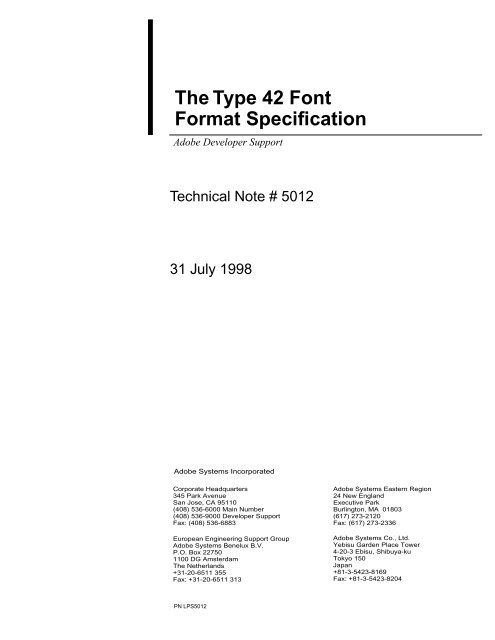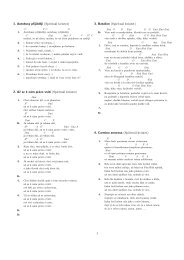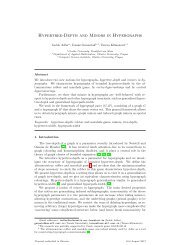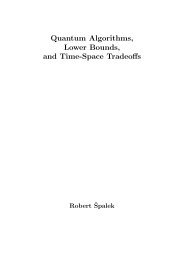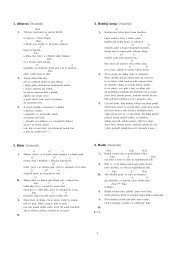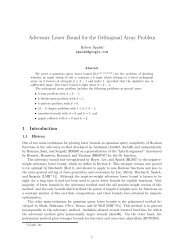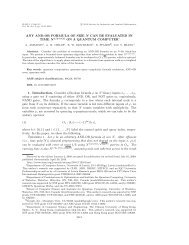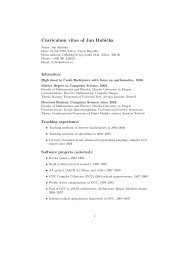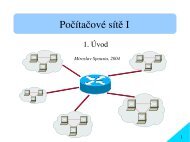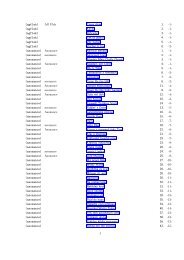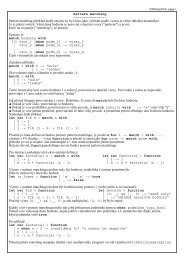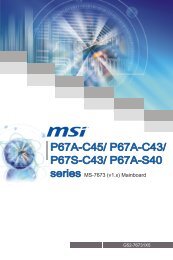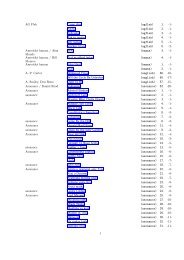Type 42 Font Format Specification - Adobe
Type 42 Font Format Specification - Adobe
Type 42 Font Format Specification - Adobe
Create successful ePaper yourself
Turn your PDF publications into a flip-book with our unique Google optimized e-Paper software.
The <strong>Type</strong> <strong>42</strong> <strong>Font</strong><strong>Format</strong> <strong>Specification</strong><strong>Adobe</strong> Developer SupportTechnical Note # 501231 July 1998<strong>Adobe</strong> Systems IncorporatedCorporate Headquarters345 Park AvenueSan Jose, CA 95110(408) 536-6000 Main Number(408) 536-9000 Developer SupportFax: (408) 536-6883European Engineering Support Group<strong>Adobe</strong> Systems Benelux B.V.P.O. Box 227501100 DG AmsterdamThe Netherlands+31-20-6511 355Fax: +31-20-6511 313<strong>Adobe</strong> Systems Eastern Region24 New EnglandExecutive ParkBurlington, MA 01803(617) 273-2120Fax: (617) 273-2336<strong>Adobe</strong> Systems Co., Ltd.Yebisu Garden Place Tower4-20-3 Ebisu, Shibuya-kuTokyo 150Japan+81-3-5<strong>42</strong>3-8169Fax: +81-3-5<strong>42</strong>3-8204PN LPS5012
Copyright © 1993, 1998 by <strong>Adobe</strong> Systems Incorporated. All rights reserved.NOTICE: All information contained herein is the property of <strong>Adobe</strong> Systems Incorporated.No part of this publication (whether in hardcopy or electronic form) may be reproduced or transmitted,in any form or by any means, electronic, mechanical, photocopying, recording, or otherwise, withoutthe prior written consent of the publisher.PostScript is a registered trademark of <strong>Adobe</strong> Systems Incorporated. All instances of the name Post-Script in the text are references to the PostScript language as defined by <strong>Adobe</strong> Systems Incorporatedunless otherwise stated. The name PostScript also is used as a product trademark for <strong>Adobe</strong> Systems’implementation of the PostScript language interpreter.Except as otherwise stated, any reference to a “PostScript printing device,” “PostScript displaydevice,” or similar item refers to a printing device, display device or item (respectively) which containsPostScript technology created or licensed by <strong>Adobe</strong> Systems Incorporated and not to devices or itemswhich purport to be merely compatible.<strong>Adobe</strong>, PostScript, PostScript 3, and the PostScript logo are trademarks of <strong>Adobe</strong> Systems Incorporated.True<strong>Type</strong> is a trademark and Apple, Macintosh, and LaserWriter are registered trademarks ofApple Computer, Incorporated. Windows is a trademark and Microsoft is a registered trademark ofMicrosoft Corporation. All other trademarks are the property of their respective owners.This publication and the information herein is furnished AS IS, is subject to change without notice,and should not be construed as a commitment by <strong>Adobe</strong> Systems Incorporated. <strong>Adobe</strong> SystemsIncorporated assumes no responsibility or liability for any errors or inaccuracies, makes no warrantyof any kind (express, implied, or statutory) with respect to this publication, and expressly disclaimsany and all warranties of merchantability, fitness for particular purposes, and noninfringementof third party rights.
ContentsThe <strong>Type</strong> <strong>42</strong> <strong>Font</strong><strong>Format</strong> <strong>Specification</strong> 11 Introduction 12 The <strong>Type</strong> <strong>42</strong> <strong>Font</strong> <strong>Format</strong> 2<strong>Type</strong> <strong>42</strong> <strong>Font</strong> Comment Lines 3The <strong>Type</strong> <strong>42</strong> <strong>Font</strong> Dictionary 3Implications of The Glyph Coordinate System 63 Identifying Interpreters with True<strong>Type</strong> Rasterizers 64 Conversion Issues 7The <strong>Font</strong>Info Dictionary 7The sfnts Array 7Generating The CharStrings Dictionary 9Generating the Encoding Vector 9Glyph Mapping and Metrics Access 10Generating Unique Identifiers 11Required True<strong>Type</strong> Tables 125 CID<strong>Font</strong><strong>Type</strong> 2 CID <strong>Font</strong>s 12Complete <strong>Font</strong> Downloading 13Incremental <strong>Font</strong> Downloading 14CMap Resources for CID<strong>Font</strong><strong>Type</strong> 2 CID <strong>Font</strong>s 15Changes to CIDMap 15GlyphDirectory 16Vertical Writing Mode 18MetricsCount 186 Known Bugs 207 Example <strong>Type</strong> <strong>42</strong> single-byte font program 20Index 23iii
iv Contents (31 Jul 98)
The <strong>Type</strong> <strong>42</strong> <strong>Font</strong><strong>Format</strong> <strong>Specification</strong>1 IntroductionThis document describes the PostScript ® <strong>Type</strong> <strong>42</strong> font format which can beused to download True<strong>Type</strong> ® fonts to PostScript printers (or PostScriptcompatible printers) that contain a True<strong>Type</strong> rasterizer. This method yieldsbetter print quality than can be achieved by converting a True<strong>Type</strong> font to a<strong>Type</strong> 1 or <strong>Type</strong> 3 font. Performance may also be improved for large Chinese,Japanese, or Korean (CJK) fonts when the print driver takes advantage ofglyph subsetting and incremental downloading.A <strong>Type</strong> <strong>42</strong> font dictionary contains the True<strong>Type</strong> font embedded as a stringvalue for the sfnts keyword. For single-byte Roman True<strong>Type</strong> fonts, the sfntsarray typically contains the complete True<strong>Type</strong> font. This was first supportedin PostScript version 2010 for printers that contain the optional True<strong>Type</strong>rasterizer. Other entries in the <strong>Type</strong> <strong>42</strong> font dictionary permit the PostScriptinterpreter to handle the font in a manner similar to a <strong>Type</strong> 1 font, and tomake the True<strong>Type</strong> font data available to the True<strong>Type</strong> rasterizer.This version of this document, dated June 1998, adds a description of how toconvert multi-byte True<strong>Type</strong> fonts into CID<strong>Font</strong><strong>Type</strong> 2 CID fonts. This takesadvantage of the CID format’s ability to encode the large number of glyphsneeded for most CJK fonts. Both permanent downloading to a printer’s harddisk, and font embedding for a print job are explained.Support for multi-byte CJK True<strong>Type</strong> fonts was added in version 2015 of thePostScript interpreter by providing a mechanism for subsetting andincremental downloading of large fonts. Recent updates for version 3011support further optimizations to improve printing performance.This document only describes the format of a <strong>Type</strong> <strong>42</strong> font program and howit may be created from a True<strong>Type</strong> font. The True<strong>Type</strong> specification fromApple Computer is available at the following URL:< http://fonts.apple.com/TTRefMan/index.html >Microsoft’s True<strong>Type</strong> specification is available at the following URL:1
http://www.microsoft.com/typography/tt/tt.htm >Additional information on <strong>Type</strong> <strong>42</strong> fonts can be found in: The PostScriptLanguage Reference Manual Supplements for versions 2015, 3010, and3011. Also, see <strong>Adobe</strong> Technical Note #5213, “PostScript LanguageExtensions for CID-Keyed <strong>Font</strong>s (PostScript Software Version 2015).”2 The <strong>Type</strong> <strong>42</strong> <strong>Font</strong> <strong>Format</strong>The True<strong>Type</strong> font format was originally developed by Apple Computer, andis the native font format used by the Macintosh and Windows operatingenvironments. Until recently, Macintosh print drivers would download eitherthe True<strong>Type</strong> font and the True<strong>Type</strong> rasterizer to interpreters with 680X0-class controllers, or convert the font into a PostScript <strong>Type</strong> 1 (unhinted) fontprogram. Windows print drivers would either convert to <strong>Type</strong> 1 or <strong>Type</strong> 3, orrasterize the True<strong>Type</strong> font on the host, and download a bitmap <strong>Type</strong> 3 or<strong>Type</strong> 32 font. All of these methods have disadvantages: the True<strong>Type</strong>rasterizer is large; conversion to <strong>Type</strong> 1 format loses the hint information andthe translation of True<strong>Type</strong> quadratic to PostScript Bézier curves cannot beexact; and bitmap fonts cannot be scaled for multiple resolutions retain thenecessary quality.Many PostScript interpreters, beginning with version 2013, now include aTrue<strong>Type</strong> rasterizer; they can be identified from the PostScript PrinterDescription (PPD) file (see section 3). For a True<strong>Type</strong> font to be recognizedby a PostScript interpreter, it must be enclosed in a PostScript font dictionarywith <strong>Font</strong><strong>Type</strong> <strong>42</strong>, or as a CID font with CID<strong>Font</strong><strong>Type</strong> 2 and <strong>Font</strong><strong>Type</strong> <strong>42</strong>.<strong>Font</strong><strong>Type</strong> <strong>42</strong> and CID<strong>Font</strong><strong>Type</strong> 2 are standard part of LanguageLevel 3; allversion 3010 and greater interpreters support them. However, the version3011 extensions are not part of LanguageLevel 3.NoteAlthough the keyword name sfnts is derived from the Macintosh resourcetype used for True<strong>Type</strong> fonts, True<strong>Type</strong> fonts from the Windows environmentcan be converted in an identical manner.A <strong>Type</strong> <strong>42</strong> font is a base font and shares all the properties of base fonts asdocumented in the PostScript Language Reference Manual, second edition.In particular, presence of an unique identifier such as an XUID facilitatesbitmap caching for a <strong>Type</strong> <strong>42</strong> font just as it does for any other type of basefont. When <strong>Type</strong> <strong>42</strong> fonts are permanently downloaded to a hard diskconnected to a PostScript printer, only the charstrings actually referenced inthe print job will be read into VM, thus saving memory (see section 4.2).Also, glyphs can be modified or added to the <strong>Type</strong> <strong>42</strong> font by using userdefinedPostScript language procedures (See section 5.6.3 in The PostScriptLanguage Reference Manual, second edition.).2 The <strong>Type</strong> <strong>42</strong> <strong>Font</strong> <strong>Format</strong> <strong>Specification</strong> (31 Jul 98)
2.1 <strong>Type</strong> <strong>42</strong> <strong>Font</strong> Comment LinesThe first line of a <strong>Type</strong> <strong>42</strong> font program shall be:%!PS-True<strong>Type</strong><strong>Font</strong>-TTVersion-MfrRevisionwhere TTVersion is the True<strong>Type</strong> version number of the font (specified in theheader); MfrRevision is the font manufacturer’s revision number of the font.This line helps downloaders to easily identify True<strong>Type</strong> <strong>Type</strong> <strong>42</strong> fonts on theprinter’s hard disk.The first portion of the comment line: %!PS-True<strong>Type</strong><strong>Font</strong>, is required fordisk-based <strong>Type</strong> <strong>42</strong> fonts on any interpreter that supports <strong>Type</strong> <strong>42</strong>. If the fonthas the required portion of the comment line and it conforms to therequirements listed in section 4.2, the embedded True<strong>Type</strong> glyph data will beaccessed from disk on demand rather than reading the entire font into VM.Another useful and recommended comment line specifies the VM usage:%%VMusage: MinMemory MaxMemorywhere MinMemory and MaxMemory specify the minimum memory neededfor the font and how much is needed if the font is downloaded first (thesenumbers are not necessarily the same; see The <strong>Adobe</strong> <strong>Type</strong> 1 <strong>Font</strong> <strong>Format</strong>,version 1.1, Addison Wesley, 1990). This comment is not used by thePostScript interpreter, but is useful for application programs. The PostScriptoperator resourcestatus can be used to obtain the VM requirements for a fontresource.The values for the VMusage comment can be derived from a True<strong>Type</strong> fontwhich contains a post table (which contains information useful for PostScriptprinting). For downloading purposes, the size of the font can be used as anestimate for the values for VMusage. However, a properly constructed<strong>Type</strong> <strong>42</strong> font on a printer’s hard disk will generally require only a percentageof the VM required for the downloadable version of the font.2.2 The <strong>Type</strong> <strong>42</strong> <strong>Font</strong> DictionaryTable 1 lists entries common to all types of font dictionaries. Table 2 listsadditional key-value pairs that are meaningful in all base fonts. Table 3 listsadditional key-value pairs that are meaningful in <strong>Type</strong> <strong>42</strong> fonts. See thecorresponding tables 5.1 through 5.3 in The PostScript Language ReferenceManual, second edition.2 The <strong>Type</strong> <strong>42</strong> <strong>Font</strong> <strong>Format</strong> 3
Key <strong>Type</strong> DescriptionTable 1 Entries in all types of font dictionaries<strong>Font</strong><strong>Type</strong> integer (Required) Value must be <strong>42</strong>.<strong>Font</strong>Matrix array[6] (Required) Transforms the glyph coordinate system into the usercoordinate system. <strong>Type</strong> <strong>42</strong> fonts, unlike <strong>Type</strong> 1 fonts, are usuallydefined in terms of an identity transform, so the value of <strong>Font</strong>Matrixshould be [1 0 0 1 0 0]. See section 2.3 for a discussion of theimplications of this choice of coordinate system. <strong>Font</strong>Matrix must be aliteral array.<strong>Font</strong>Name name (Optional) The font program’s PostScript font name, derived from theTrue<strong>Type</strong> name table.<strong>Font</strong>Info dictionary (Optional) See The PostScript Language Reference Manual, secondedition, Table 5.4, page 268.Key <strong>Type</strong> DescriptionTable 2 Additional entries in all base fonts (<strong>Font</strong><strong>Type</strong> not 0)Encoding array[256] (Required) An array of 256 glyph names ordered by glyph code value.The encoding is most likely to be either the Apple standard encoding orthe Windows ANSI encoding, but other encodings will occur. Seesection 4.4, “Generating the Encoding Vector.” Encoding must be aliteral array.<strong>Font</strong>BBox array[4] (Required) See description in The PostScript Language ReferenceManual, second edition, Table 5.2. Derived from the True<strong>Type</strong> headtable. See also section 2.3, “Implications of The Glyph CoordinateSystem.”UniqueID integer (Optional) See section 4.6, “Generating Unique Identifiers.”XUID array (Optional) Array of integers that uniquely identifies this font or anyvariant of it. See section 5.8 of The PostScript Language ReferenceManual, second edition. XUID must be a literal array.Key <strong>Type</strong> DescriptionTable 3 Additional and modified entries in <strong>Type</strong> <strong>42</strong> fontsPaint<strong>Type</strong> integer (Required) 0 for filled glyphs; 2 for stroked glyphs.4 The <strong>Type</strong> <strong>42</strong> <strong>Font</strong> <strong>Format</strong> <strong>Specification</strong> (31 Jul 98)
StrokeWidth number (Optional) The width of the line used to stroke outline fonts (Paint<strong>Type</strong>= 2), in glyph coordinates. This number is interpreted in glyph space;see section 2.3, “Implications of The Glyph Coordinate System.”Metrics dictionary (Optional) Width and sidebearing information for writing mode 0. Notnormally present in the original definition of a font; adding thisdictionary to a font overrides the widths and sidebearings encoded inthe glyph definitions in the True<strong>Type</strong> font. This dictionary will onlyaffect <strong>Type</strong> <strong>42</strong> fonts in version number 2013 and greater of thePostScript interpreter. The values in this dictionary are interpreted inglyph space; see section 2.3, “Implications of The Glyph CoordinateSystem.”Metrics2 dictionary (Optional) Width and sidebearing information for writing mode 1. Ingeneral this dictionary is only interpreted by LanguageLevel 1 deviceswith composite font extensions and all LanguageLevel 2 devices; for<strong>Type</strong> <strong>42</strong> fonts it is only recognized by PostScript interpreter version2013 and greater. The values in this dictionary are interpreted in glyphspace; see section 2.3, “Implications of The Glyph Coordinate System.”CDevProc procedure Algorithmically derives global changes to a font’s metrics. See ThePostScript Language Reference Manual, second edition, p. 277.CDevProc works the same in a <strong>Type</strong> <strong>42</strong> font as in a <strong>Type</strong> 1 font, asidefrom the different glyph coordinate system; see section 2.3,“Implications of The Glyph Coordinate System.”CharStrings dictionary (Required) Associates glyph names with glyph descriptions. If anentry’s value is an integer, it is used as an index into the True<strong>Type</strong> locatable, which contains the byte offsets of glyph definitions in the glyftable. If the value is a procedure (executable array or packed array), it isinterpreted as described in section 5.6.3 of The PostScript LanguageReference Manual, second edition. This dictionary must have an entrywhose key is .notdef.sfnts array (Required) An array of one or more PostScript language string objectscontaining the binary True<strong>Type</strong> font. (see section 4.2 for information onthe constraints and format).CIDMap array, string, (Required) Maps CIDs to glyph indices. If CIDMap is a string, it isinteger, or dictionary treated as an array of glyph index values, each of which is GDByteslong, stored high-order byte first. If CIDMap is an array of strings, thestrings are logically concatenated; each must be a multiple of GDByteslong. If CIDMap is a dictionary, its keys are CIDs and its values areintegers representing glyph indices. If CIDMap is an integer, it is simplyadded to the CID to yield a glyph index. See Section 5.4, “Changes toCIDMap.”2 The <strong>Type</strong> <strong>42</strong> <strong>Font</strong> <strong>Format</strong> 5
GDBytes integer (Required if CIDMap is a string or array) Number of bytes representingeach glyph index in the CIDMap.GlyphDirectory array or (Optional) See Section 5.5, “GlyphDirectory.”dictionaryMetricsCount integer (Optional) 0, 2, or 4. Default value: 0See Section 5.7, “MetricsCount.”2.3 Implications of The Glyph Coordinate SystemAs indicated in Table 1, a <strong>Type</strong> <strong>42</strong> font’s glyph coordinate system is typicallydefined as an identity transform. This is in contrast to a <strong>Type</strong> 1 font, whoseglyph coordinate system is typically defined at a 1000 unit scale relative touser space.This difference has implications regarding the interpretation of fontdictionary entries whose values are defined in glyph space. If a PostScriptprogram adds or changes such entries in a font dictionary, it must choosevalues that are appropriate for the font’s glyph coordinate system. Inparticular, values that would be appropriate for a <strong>Type</strong> 1 font will be 1000times too large for a <strong>Type</strong> <strong>42</strong> font.The font dictionary entries for which this issue arises include:• The value of StrokeWidth (when Paint<strong>Type</strong> has been set to 2);• The contents of the Metrics and Metrics2 dictionaries;• The operands and results of the CDevProc procedure;• The values of UnderlinePosition and UnderlineThickness in the <strong>Font</strong>Infodictionary.• The values in the <strong>Font</strong>BBox array.3 Identifying Interpreters with True<strong>Type</strong> RasterizersPostScript interpreters with True<strong>Type</strong> rasterizers can be identified from thefollowing entry in the device’s PPD file (version 4.1 of the specification):*TTRasterizer: RasterizerOption6 The <strong>Type</strong> <strong>42</strong> <strong>Font</strong> <strong>Format</strong> <strong>Specification</strong> (31 Jul 98)
where RasterizerOption can be any of the following:NoneNo True<strong>Type</strong> rasterizer is present, and the device is notcapable of receiving a downloadable rasterizer. To use aTrue<strong>Type</strong> font on this interpreter, it must be converted to a<strong>Type</strong> 1 or <strong>Type</strong> 3 font.Accept68KNo True<strong>Type</strong> rasterizer is built-in, but the device has a680X0-based controller and enough memory to accept adownloadable True<strong>Type</strong> rasterizer. (The code toaccomplish this is proprietary to Apple Computer, and isnot generally available).<strong>Type</strong><strong>42</strong>The device has a <strong>Type</strong> <strong>42</strong> True<strong>Type</strong> rasterizer in ROM.A PostScript program can determine whether a LanguageLevel 2 or 3 devicesupports <strong>Type</strong> <strong>42</strong> fonts (no LanguageLevel 1 devices support <strong>Type</strong> <strong>42</strong>) byexecuting:<strong>42</strong> /<strong>Font</strong><strong>Type</strong> resourcestatus {pop pop true} {false} ifelsewhich pushes true or false on the stack depending on whether <strong>Type</strong> <strong>42</strong> fontsupport is present.4 Conversion IssuesThe following sections discuss issues related to converting a True<strong>Type</strong> fontinto a <strong>Type</strong> <strong>42</strong> font.4.1 The <strong>Font</strong>Info DictionaryThe optional <strong>Font</strong>Info dictionary may be constructed from entries in the nameand post tables in the True<strong>Type</strong> font. It is not used by the PostScriptinterpreter, but some PostScript programs may utilize entries such asUnderlinePosition and UnderlineThickness.4.2 The sfnts ArrayIn VM, a True<strong>Type</strong> font is represented as an array named sfnts consists ofPostScript string objects which, when concatenated, represent the entireTrue<strong>Type</strong> font. Multiple strings may be required due to the PostScriptlanguage implementation limit of 65535 bytes in a string.When a True<strong>Type</strong> font is divided into multiple strings, for compatibility withpre-2013 interpreters, the strings must begin at True<strong>Type</strong> table boundaries, orat individual glyph boundaries within the glyf table. The True<strong>Type</strong> file formatrequires that tables begin at 4-byte boundaries and that individual glyph4 Conversion Issues 7
descriptions begin at 2-byte boundaries. Therefore, each string will containan even number of bytes of True<strong>Type</strong> data. There is a practical limit of 64 Kon the size of tables (except for the glyf table), until PostScript version 3011.For compatibility with <strong>Type</strong> <strong>42</strong> implementations in PostScript interpreterversions prior to 2013, each string must have one additional padding byteappended by adding “00” to the hex data in the file. That is, the length of eachstring must be odd. The last byte is not logically part of the True<strong>Type</strong> fontdata and is ignored by the interpreter.The sfnts array is expressed as a series of strings:/sfnts [ … ] defIn the font file, the strings are made up of lines of hexadecimal characters.The characters in each line may be preceded, followed, and divided by anarbitrary (but consistent) number of white space or control characters (see theadditional compatibility constraint in the bullet list below for fontsdownloaded to a hard disk).For <strong>Type</strong> <strong>42</strong> fonts to be downloaded to a printer’s disk (or other file systemhardware), there are specific additional constraints on the text representationof that array in the file. Observing these constraints and beginning the filewith the correct comment line (see section 2.1) enables the PostScriptinterpreter to have dynamic access to the font file on an as-needed basis,which has significant implications for saving VM. If a <strong>Type</strong> <strong>42</strong> font has thecorrect initial comment line but does not conform to the constraints listedbelow, the result will be an invalidfont error on some interpreters.Although newer versions of the PostScript interpreter are likely to have fewerrestrictions on the format of the sfnts array, the following constraints shouldbe used, for backward compatibility purposes, to enable dynamic access to adisk-based font file:• There may be whitespace and/or control characters between the /sfnts, the‘[’, and the ‘’ and the next string’s ‘
The strings in the sfnts array may be represented in binary in the same way asmay be used for <strong>Type</strong> 1 charstrings (see section 2.4 in the <strong>Adobe</strong> <strong>Type</strong> 1 <strong>Font</strong><strong>Format</strong> book). However, fonts using this representation cannot be installed ondisk in PostScript interpreter versions prior to 2013. Also, they cannot besafely transmitted across non-binary channels, so fonts in this format shouldnot be embedded in documents. Use of this format should be limited to diskfont installer utilities that know something about the capabilities of thePostScript interpreter being accessed.To represent a string in a binary representation, a PostScript languageprocedure must be defined with the following code:/RD {string currentfile exch readstring pop} executeonly defEach use of RD is followed by exactly one blank character followed by asequence of binary bytes that are the string contents:n RD ~binary~bytes~ {noaccess def} executeonly defRD itself is preceded by an integer n which is the number of binary bytesfollowing the RD (not including the single blank that follows the RD).The following is an example of a two-element sfnts array encoded in thisway:/sfnts [62135 RD ~62135~binary~bytes~12093 RD ~12093~binary~bytes~] defEach string contains an even number of bytes of True<strong>Type</strong> data, followed byone byte of padding which the PostScript interpreter ignores.4.3 Generating The CharStrings DictionaryThe CharStrings dictionary for a <strong>Type</strong> <strong>42</strong> font is a standard dictionary ofkey/value pairs, where the key is the glyph’s name (derived from the True<strong>Type</strong>font’s cmap table), and the value is an index number into the True<strong>Type</strong> font’sloca (glyph offsets) table. The value in the key/value pair may also be aPostScript language procedure (executable array or packed array); see section5.6.3 of the The PostScript Language Reference Manual, second edition.4.4 Generating the Encoding VectorNoteThe /Encoding vector associates a code point with a glyph name. The glyphname is used to look up the glyph’s glyph id in the Charstrings dictionary.Glyph names can either be inferred by the encoding used by the font, or canbe derived from glyph names in the font’s post table—if the font’s post tableis of a version that allows glyph names.4 Conversion Issues 9
True<strong>Type</strong> fonts used in the Windows or Macintosh environments willgenerally use the encoding specific to that system, such as ANSI for Windowsand the Apple encoding for the Macintosh. The platform-specific encodingcan be determined by the platform ID number in a subtable of the cmap table.The post table lists glyph names that differ from the platform’s standardencoding. Only versions 1.0, 2.0, and 2.5 of the post table allow the inclusionof glyph names. <strong>Format</strong>s 3.0 (the one used in most True<strong>Type</strong> fonts), and 4.0,do not contain glyph names. If there is no post table in a True<strong>Type</strong> font in theWindows environment, the Windows ANSI encoding can be assumed.When downloading and installing a <strong>Type</strong> <strong>42</strong> font on a printer’s hard disk, it isessential that the software use a naming convention that is consistent withthat used by software on any host system that might be connected to theprinter.4.5 Glyph Mapping and Metrics AccessFigure 1 illustrates how True<strong>Type</strong> glyph descriptions and metrics arereferenced by character codes and names in a <strong>Type</strong> <strong>42</strong> font dictionary.Figure 1 <strong>Type</strong> <strong>42</strong> <strong>Font</strong> Glyph Mapping<strong>Type</strong> <strong>42</strong><strong>Font</strong> dictionary:/EncodingTrue<strong>Type</strong> font in /sfnts array:cmap(character codesto glyph index)hmtx(horizontal metrics)/a/b98 143143/Charstrings(glyph name toglyph index).notdef 0loca(GI / byte offset forglyph description)glyf(glyph descriptions)/a/b1<strong>42</strong>14314327328When a printer driver builds a <strong>Type</strong> <strong>42</strong> font, it uses the True<strong>Type</strong> cmap tableto map character codes to glyph indices, which enables it to build the/Charstrings dictionary (which associates PostScript character names withTrue<strong>Type</strong> glyph indices). However, the cmap table is not used by thePostScript interpreter, so it need not be downloaded.The PostScript interpreter uses the /Encoding array to look up the charactername, which is then used to access the /Charstrings entry with that name.The value of that entry is the glyph index, which is then used to retrieve theglyph description’s byte offset in the loca table. The glyph index is also used10 The <strong>Type</strong> <strong>42</strong> <strong>Font</strong> <strong>Format</strong> <strong>Specification</strong> (31 Jul 98)
to get metrics from the hmtx. As of PostScript interpreter version 3011, theglyph index can also be used to get vertical metrics from the vmtx table (seesection 5.6, “Vertical Writing Mode”).4.6 Generating Unique IdentifiersThe <strong>Type</strong> <strong>42</strong> font may contain an unique identifier which allows the glyphbitmaps to be cached across print jobs (see also section 5.8 of The PostScriptLanguage Reference Manual, second edition). This entry is optional buthighly desirable since many users may use the same fonts in every print job.Bitmaps generated from True<strong>Type</strong> fonts in <strong>Type</strong> <strong>42</strong> format use the samecaching system as is used for <strong>Type</strong> 1 fonts. When a glyph bitmap is neededfrom a <strong>Type</strong> <strong>42</strong> font, the glyph cache is checked first. If the bitmap has notbeen cached, the bitmap is produced from the outline font program.True<strong>Type</strong> fonts do not contain any type of unique number which eithercorresponds to the PostScript language UniqueID entry or could be used forsuch. Using something like a checksum number as a UniqueID value deviceswould not be advisable since it does not assure uniqueness. Although thisapproach would work in many situations, there is an increased andunacceptable risk when, as at a service bureau, bitmaps are cached on a harddisk for a potentially long period of time. Hence, the performance gainresulting from caching does not offset the danger of a user getting incorrectbitmaps from the cache.Since True<strong>Type</strong> rasterizers only exist in LanguageLevel 2 interpreters, theXUID operator offers a safer opportunity to cache bitmaps. The XUID(extended unique ID) is an array of integers which provides for distributed,hierarchical management of UniqueID numbers. The goal is to have amechanism for generating an XUID array of values, on-the-fly, which areunique for every font, yet exactly repeatable since a True<strong>Type</strong> font in a user’ssystem may be converted multiple times to a <strong>Type</strong> <strong>42</strong> for printing.A recommended method for generating a number for a given font which isboth more likely to be unique than a simple checksum and exactly repeatable,is to use the MD5 algorithm from RSA Data Security, Incorporated. Theirsoftware can be copied and freely distributed if it is properly identified. Thecode for this algorithm is readily available from:RSA Data Security, Inc.100 Marine ParkwayRedwood City, CA 94065The goal is to generate an XUID array of five elements, with the first havingthe value of <strong>42</strong> (decimal). This value has been registered in the <strong>Adobe</strong> XUIDregistry for use by software in creating <strong>Type</strong> <strong>42</strong> fonts. The MD5 algorithm4 Conversion Issues 11
can then be used to generate a 128-bit number, using the font file as input.This number can then be divided into four 32-bit integers to make the otherfour elements of the array. Some optimization of the algorithm code may benecessary to enhance performance.4.7 Required True<strong>Type</strong> TablesIn creating a <strong>Type</strong> <strong>42</strong> font from a True<strong>Type</strong> font, only a subset of all potentialtables in the original font are actually used by the rasterizer in the PostScriptinterpreter. The following tables are the set of tables that are used by theTrue<strong>Type</strong> rasterizer. Not all of these tables are required for everyconfiguration of a <strong>Type</strong> <strong>42</strong> font.head prep cvt_hhea fpgm maxphmtx vhea vmtxlocaglyfThe tables vhea and vmtx are only supported in version 3011 or higher, andonly when MetricsCount has a value of 0 or 2, or if the MetricsCountkeyword is not included. Also, for compatibility reasons, CDevProc shouldbe included for vertical writing mode.Since a significant number of tables may be included in a True<strong>Type</strong> font(including potentially large kerning and metrics tables), performance may beimproved by including in the downloadable <strong>Type</strong> <strong>42</strong> font only the tablesactually used by the True<strong>Type</strong> rasterizer.5 CID<strong>Font</strong><strong>Type</strong> 2 CID <strong>Font</strong>sVersion 2015 of the PostScript interpreter introduced support for largeChinese, Japanese, and Korean (CJK) multi-byte True<strong>Type</strong> fonts bysupporting the use of CID fonts that contain True<strong>Type</strong> glyphs. The CID fontformat allows thousands of glyphs to be encoded and accessed. The CID fontmust have the keyword/values CID<strong>Font</strong><strong>Type</strong> 2, and <strong>Font</strong><strong>Type</strong> <strong>42</strong>. Forinformation on the CID format, see Technical Note #5014, <strong>Adobe</strong> CMap andCID<strong>Font</strong> Files <strong>Specification</strong>.For downloading and installing a CID<strong>Font</strong><strong>Type</strong> 2 CID font to a printer’s harddisk, the font should contain the True<strong>Type</strong> font embedded in the sfnts array.The number of tables included can be limited to only those tables used by therasterizer (see section 4.7, “Required True<strong>Type</strong> Tables”). The inclusion ofother tables depends on the desired optimizations for printing speed, orwhether the font is to be permanently downloaded to a printer’s hard disk. Forexample, for vertical writing, a GlyphDirectory may be included in the12 The <strong>Type</strong> <strong>42</strong> <strong>Font</strong> <strong>Format</strong> <strong>Specification</strong> (31 Jul 98)
PostScript portion of the font if the font is to be subsetted or incrementallydownloaded; but for disk-based fonts, including the vhea and vmtx tables inthe sfnts array gives better performance.A large CJK True<strong>Type</strong> font may have 35,000 glyphs, as well as a number ofvery large data tables. For a CID<strong>Font</strong><strong>Type</strong> 2 CID font that is to be downloadedfor printing a specific document, a number of optimizations can be made tolimit the amount of data that must be downloaded. For example, the font canbe subsetted to include only the glyphs needed in the document, and thoseglyphs can be downloaded incrementally on an as-needed basis. Theseoptimizations can improve performance as well as save VM, which helps toensure that a document will print when memory is low.5.1 Complete <strong>Font</strong> DownloadingWhen downloading a True<strong>Type</strong> font to a printer’s hard disk, the optimizationsfor subsetting and incremental downloading are not used because the full fontmust be available.Figure 2 shows the configuration for glyph mapping for True<strong>Type</strong> fonts to bepermanently downloaded to a printer’s hard disk. It is desirable to have a fullCIDMap, as well as full hmtx, vmtx, loca, and glyf tables. The True<strong>Type</strong> cmaptable is not shown because it is not needed by the rasterizer, but it is usedinitially by the driver software to get the glyph indices for building the/Charstrings dictionary.The interpreter maps a character code to a CID number, and uses the CID toget the True<strong>Type</strong> glyph index from CIDMap. The glyph index is then used toget horizontal or vertical metrics from the hmtx or vmtx tables, respectively. Aglyph description is obtained from the glyf table by getting its byte offset fromthe loca table.5 CID<strong>Font</strong><strong>Type</strong> 2 CID <strong>Font</strong>s 13
Figure 2 CID <strong>Type</strong> <strong>42</strong> <strong>Font</strong> for Disk InstallationCMap ResourceChar CodeiCIDiTrue<strong>Type</strong> font in /sfnts array:hmtx(horizontal metrics)vmtx(vertical metrics)<strong>Type</strong> <strong>42</strong> <strong>Font</strong> dict:/CIDMaploca(GI / byte offset forglyph description)glyf (glyphdescriptions)CIDiGIi5.2 Incremental <strong>Font</strong> DownloadingFigure 3 shows an example of how glyphs are accessed for CID<strong>Font</strong><strong>Type</strong> 2CID fonts that use a GlyphDirectory for subsetting and incrementaldownloading. The CMap resource is used to map the character code to a CIDnumber, and the CIDMap maps CIDs to glyph indices. If a special CMap canbe constructed which makes CIDMap an identity mapping, then downloadingthe identity CIDMap is wasteful and unnecessary. In this case, CIDMap cansimply be defined as an integer. The glyph index is then used to access theglyph description in GlyphDirectory.14 The <strong>Type</strong> <strong>42</strong> <strong>Font</strong> <strong>Format</strong> <strong>Specification</strong> (31 Jul 98)
Figure 3 CID<strong>Font</strong><strong>Type</strong> 2 CID Glyph Mapping for DownloadingCMap file (external)Char CodeiCIDi<strong>Type</strong> <strong>42</strong> <strong>Font</strong> dict/CIDMapCIDiGIi/GlyphDirectorykeyvalueGIi glyph description5.3 CMap Resources for CID<strong>Font</strong><strong>Type</strong> 2 CID <strong>Font</strong>sCID<strong>Font</strong><strong>Type</strong> 2 fonts must have an associated CMap resource. Since theoriginal True<strong>Type</strong> font does not have a CMap file, the driver or downloadersoftware must create one.The CMap resource (maps character codes to CIDs) can be constructed sothat the mapping in CIDMap (CIDs to glyph indices) is an identity mapping,such that:GI i = CID iBecause the resulting CIDMap uses an identity mapping, it is not necessary todownload CIDMap as a dictionary or array, thus saving a significant amountof VM. Although CIDMap is a required entry, it can be defined as having aninteger value (see “Defining CIDMap as an Integer” in section 5.4). In thegeneral case, the value of the integer would be zero.A CID-keyed font must reference the /Registry, /Ordering, and /Supplementspecified in the CMap resource. Hence, both the CID<strong>Font</strong> and the CMap mustbe built to reflect that relationship (see <strong>Adobe</strong> Technical Note #5014, <strong>Adobe</strong>CMap and CID<strong>Font</strong> Files <strong>Specification</strong>).5.4 Changes to CIDMapPrior to interpreter version 3011, a CIDMap could be either a string or anarray of strings, and was interpreted as a mapping of CIDs to glyph indices.The resulting glyph index is then used to access glyphs in either the glyf tableor the GlyphDirectory, as well as metrics data in the hmtx or vmtx tables in theTrue<strong>Type</strong> font.5 CID<strong>Font</strong><strong>Type</strong> 2 CID <strong>Font</strong>s 15
For large multi-byte fonts, CIDMaps tend to be fairly large, and if only afraction of the font’s glyphs are needed for a particular document, storagespace can be wasted. For example, the Windows Simplified Chinese fontSimHei has about 25 K glyphs and its CIDMap requires about 50 KB of filesize and VM. The following sections explain how to define CIDMap as adictionary or an integer, so only a subset of all glyph mappings need to bedownloaded. Alternatively, it can be defined as an integer, so that the CIDMapneed not be downloaded at all (except as a single value).Defining CIDMap as a DictionaryDefining CIDMap as a dictionary facilitates incremental downloading ofglyphs by allowing the downloading of only the mapping entries needed bythe current document. This can save a significant amount of both file and VMspace.Defining CIDMap as an IntegerCIDMap can be defined as having a single integer value:/CIDMap integerwhere integer is interpreted as an offset that is added to the CID obtainedfrom the CMap resource, to map to the corresponding glyph index value:GI = integer + CIDFor the general case, the value of the integer will be zero. It may alsosometimes be necessary to create a CIDMap in which there is an offset fromthe Identity mapping. For example, if it is attempted to download a True<strong>Type</strong>font with 20,000 glyphs to a printer’s hard disk, the large loca table (20K x 4bytes/entry) will not be interpreted correctly if it is split into multiple sfntsstrings. The font can be downloaded as two CID<strong>Font</strong>s, one with the glyph’sfrom 0 to n–1; and the other with glyphs from n to 20K–1 (being careful notto split composite glyphs across two fonts). Hence, a glyph index used in ahost document can be looked up using the CMap (where GI = CID) to decidewhich CID<strong>Font</strong> to use when printing.5.5 GlyphDirectoryBoth <strong>Type</strong> <strong>42</strong> and CID<strong>Font</strong><strong>Type</strong> 2 CID fonts may be created with aGlyphDirectory array or dictionary, which allows font subsetting andincremental downloading.For a CID<strong>Font</strong><strong>Type</strong> 2 font, if GlyphDirectory is a dictionary, each key is aninteger glyph index, and the value is a string containing the True<strong>Type</strong> glyphdescription. If GlyphDirectory is an array, its length must be greater than the16 The <strong>Type</strong> <strong>42</strong> <strong>Font</strong> <strong>Format</strong> <strong>Specification</strong> (31 Jul 98)
highest glyph index in the font. Each array element can be either null(indicating an empty element), or a string containing the True<strong>Type</strong> glyphdescription.Starting with PostScript version 2015, the interpreter checks for the existenceof a gdir table in the sfnts array, and if found, uses GlyphDirectory in place ofthe loca and glyf tables. This table, which is not in the True<strong>Type</strong> font formatspecification, must be inserted by the software that builds the CID<strong>Font</strong><strong>Type</strong> 2font. The size and offset of the gdir table must be zero, it is only used tospecify the use of the GlyphDirectory entry in the font dictionary.The loca or hmtx tables are of the order of magnitude of 4 bytes × numGlyphs.Thus, for incrementally downloaded or subset fonts, the choice to useGlyphDirectory avoids the need to download a large and mostly unused locatable, and saves the corresponding space in VM. For PostScript versionsbefore 3011, for these same small fonts, the large and mostly unused hmtxtable must still be downloaded. In 3011, the horizontal and vertical metricsmay be included in the GlyphDirectory, making it unnecessary to downloadthe additional tables (see section 5.7, “MetricsCount”).For large CID<strong>Font</strong><strong>Type</strong> 2 CID fonts that are to be permanently downloaded infull to a PostScript file system, GlyphDirectory should not be used because itis less efficient than using the loca and glyf table method. In addition, forcompatibility with earlier PostScript versions, some font downloadingapplications may choose to download the hmtx table (and, now, vmtx table)rather than a GlyphDirectory, in order to provide compatibility withinterpreters before 3011.Once a GlyphDirectory array or dictionary is defined, a PostScript programmay insert entries containing new glyph descriptions by replacing null arrayelements with strings or inserting new dictionary entries. It may not replaceentries that are not null; due to font caching, any attempts to do so will yieldunpredictable results. If a glyph is added to GlyphDirectory between save andrestore operations, the restore operator will remove it, since this isequivalent to replacing an entry that is not null. To avoid this problem, thedriver must download the same glyph definition again before the next attemptto perform a show operation on that glyph.As is true for all CID fonts, an attempt to perform a show operation on aglyph whose CID selects a null or missing entry in the CMap resource, theCMap will be consulted to see if there is a .notdef CID for that character code.If there is, it will be used; otherwise a CID of 0 will be used. TheGlyphDirectory entry for CID 0 must be present and not null, or aninvalidfont error will occur.If GlyphDirectory is an array, it must be allocated with enough entries to storethe highest CID or glyph index that is expected. Any unused entries in thearray will be wasted space. An array of a given length consumes about 405 CID<strong>Font</strong><strong>Type</strong> 2 CID <strong>Font</strong>s 17
percent of the memory used by a dictionary of the same length. Thus, thedictionary representation is advisable only for a sparsely populated fontcontaining less than 40 percent of the total glyphs in the font.5.6 Vertical Writing ModeCJK fonts are typically used in either horizontal or vertical typographicmodes. For vertical layout, the metrics data is available in the host font’s vmtxtable (advance height and top side bearing). It is up to the print driver todecide whether both horizontal and vertical metrics need to be included in theCID<strong>Font</strong><strong>Type</strong> 2 CID font that is to be downloaded./WMode 1 indicates that the renderer should use vertical metrics. Thus, ifMetricsCount is 0 or 2 (see section 5.7, “MetricsCount” below) the metricsdata is found in the vmtx table, which must be provided. If MetricsCount ismissing (the default value is 0, which indicates that no metrics are containedin GlyphDirectory), it is up to the creator to provide the metrics usingCDevProc or Metrics2, or both. If MetricsCount is 4, the data is found in thefirst through fourth bytes at the start of the glyph description.5.7 MetricsCountThe addition of the MetricsCount key in 3011 allows the inclusion of metricsdata in the GlyphDirectory dictionary or array. This has the advantage thatonly the metrics for the subsetted characters need be included, rather thanhaving to download complete hmtx and vmtx tables.When a key /MetricsCount is found in a CID<strong>Font</strong> with CID<strong>Font</strong><strong>Type</strong> 2, itmust be an integer with values 0, 2, or 4.Prior to 3011, the True<strong>Type</strong> rasterizer in a PostScript interpreter ignoredmetrics specified for vertical writing mode in the vmtx table, and verticalmetrics had to be supplied using a Metrics2 dictionary. For a full fontdownloaded to PostScript file system, the full Metrics2 dictionary is large andtakes up a large amount of VM. Even for a font which is incrementallydownloaded or subsetted, the Metrics2 overhead is inefficient. With 3011, thevertical metrics can be supplied using a vmtx table, or they can be embeddedin the GlyphDirectory entries for incremental downloading.18 The <strong>Type</strong> <strong>42</strong> <strong>Font</strong> <strong>Format</strong> <strong>Specification</strong> (31 Jul 98)
Table 4 shows where the metrics data is located, based on the value ofMetricsCount.Table 4 Metrics Location based on MetricsCount ValueMetricsCountNumber ofmetrics databytesHorizontalMetricsVerticalMetrics0 0 hmtx or Metricsdictionary2 4 GlyphDirectory(4 bytespreceding theglyphdescription)4 8 GlyphDirectory(second set offour bytespreceding theglyphdescription)vmtx, Metrics2dictionary, orCDevProcvmtx, Metrics2, orCDevProcGlyphDirectory(first set of fourbytes precedingthe glyphdescription—seeTable 5)MetricsCount may have a value of 0, 2, or 4. A value of 0 indicates that nometrics data is included in the GlyphDirectory, and hmtx and/or vmtx tablesare included in the font. If MetricsCount is missing, a value of 0 is implied.If MetricsCount is 2 or 4, it specifies that horizontal, or vertical andhorizontal metrics, respectively, precede the glyph description in theGlyphDirectory dictionary or array. These metrics values are copied directlyfrom the True<strong>Type</strong> glyph description, without any conversion or translation.In all cases, the glyph description will begin (2 × MetricsCount) bytes fromthe beginning of the string. If MetricsCount has a value of 2, the four bytes ofdata will be the horizontal advance width and left sidebearing. IfMetricsCount has a value of 4, then there will be eight bytes of metrics data:the vertical advance height and top sidebearing, followed by the horizontaladvance width and sidebearing, with the first byte of each pair being the highorder byte.Table 5 Metrics Data in Glyph DirectoryMetricsCount byte # semantics2 0,12,3horizontal advance widthleft sidebearing5 CID<strong>Font</strong><strong>Type</strong> 2 CID <strong>Font</strong>s 19
Table 5 Metrics Data in Glyph DirectoryMetricsCount byte # semantics4 0,12, 34, 56, 7vertical advance widthtop sidebearinghorizontal advance widthleft sidebearing6 Known BugsThere is a known bug in the True<strong>Type</strong> rasterizer included in versions of thePostScript interpreter previous to version 2013. The problem is that thetranslation components of the <strong>Font</strong>Matrix, as used as an argument to thedefinefont or makefont operators, are ignored. Translation of user space isnot affected by this bug.7 Example <strong>Type</strong> <strong>42</strong> single-byte font program%!PS-True<strong>Type</strong><strong>Font</strong>-65536-65536-111 dict begin/<strong>Font</strong>Name /Chicago def/Encoding 256 array0 1 255{1 index exch/.notdef put}fordup 0 /.null putdup 1 /option putdup 2 /control put%%... many Encoding array entries omitted...%dup 253 /hungarumlaut putdup 254 /ogonek putdup 255 /caron putreadonly def/Paint<strong>Type</strong> 0 def/<strong>Font</strong>Matrix [1 0 0 1 0 0] def/<strong>Font</strong>BBox[-190 -283 1164 1090] def/<strong>Font</strong><strong>Type</strong> <strong>42</strong> def/XUID [<strong>42</strong> 16#7880BE99 16#AC616C9D 16#D021DE98 16#1F9CD56E] def%% Optional <strong>Font</strong>Info dictionary may be inserted here%/sfnts[]def/CharStrings 279 dict dup begin/.notdef 0 def/.null 1 def/nonmarkingreturn 2 def/space 3 def/exclam 4 def /quotedbl 5 def/numbersign 6 def/dollar 7 def/percent 8 def/ampersand 9 def%20 The <strong>Type</strong> <strong>42</strong> <strong>Font</strong> <strong>Format</strong> <strong>Specification</strong> (31 Jul 98)
%...many CharStrings entries omitted...%/checkmark 273 def/linebreakltor 274 def/linebreakrtol 275 def /markingnobreakspace 276 def/diamond 277 def/appleoutline 278 def end readonly def<strong>Font</strong>Name currentdict end definefont pop7 Example <strong>Type</strong> <strong>42</strong> single-byte font program 21
22 The <strong>Type</strong> <strong>42</strong> <strong>Font</strong> <strong>Format</strong> <strong>Specification</strong> (31 Jul 98)
IndexSymbols.notdef 5Bbitmap cache 11bugs 20CCDevProc 5character coordinate system 6comment lines 3conversion issues 7F<strong>Font</strong>Info dictionary 4, 6<strong>Font</strong>Matrix 20<strong>Font</strong><strong>Type</strong> 4, 7Gglyph coordinate system 4, 6Hhard disk 2, 3Iinvalidfont error message 8Mmakefont 20MD5 algorithm 11Metrics 5Metrics2 6PPaint<strong>Type</strong> 4PPD file 2, 6Rresourcestatus 3Ssfnts 2, 8stringbinary representation 9StrokeWidth 6TTrue<strong>Type</strong> rasterizer 2, 6, 7, 20True<strong>Type</strong> specification 1True<strong>Type</strong> tablecmap 9, 10cvt_ 12glyf 5, 12head 12hhea 12loca 5, 9name 4, 7post 3, 7, 10prep 12<strong>Type</strong> <strong>42</strong> <strong>Font</strong> Dictionary 3UUnderlinePosition 7UnderlineThickness 6, 7VVM 2, 323
VMusage comment 324 Index (31 Jul 98)


